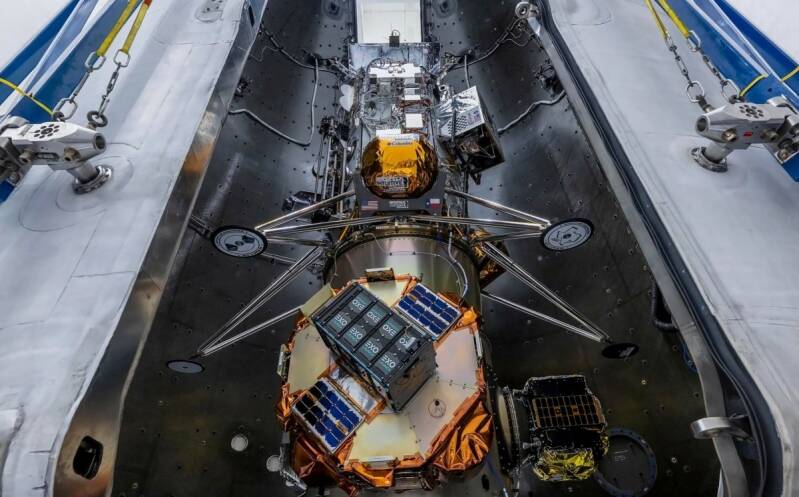Intuitive Machines is preparing for its second lunar landing mission, IM-2, which aims to deliver NASA and commercial payloads to the Moon. The mission is set to launch aboard a SpaceX Falcon 9 rocket from Kennedy Space Center, with the launch window opening on the evening of February 26.

The IM-2 lunar lander and its secondary payloads pictured on payload adaptor of Falcon 9 before launch. Credit: SpaceX
During a briefing on February 25, representatives from NASA and Intuitive Machines confirmed that preparations for launch were on track. However, they refrained from disclosing an exact launch time, instead deferring to SpaceX, which was not present at the briefing. While SpaceX has not officially announced a launch time, sources such as the Kennedy Space Center Visitor Complex website list the target as 7:17 p.m. Eastern.
The mission has a four-day launch window. If the launch occurs within the first three days, the lander is expected to reach Mons Mouton in the Moon’s south polar region by midday Eastern time on March 6. A launch on the last day of the window would push the landing attempt to March 7.
The IM-2 lander, named Athena, will carry NASA’s Polar Resources Ice Mining Experiment 1 (PRIME-1) payload as part of the agency’s Commercial Lunar Payload Services (CLPS) program. PRIME-1 is designed to drill up to a meter below the lunar surface and analyze volatiles, such as water ice, that may be present.
Additionally, the lander will carry a laser retroreflector, a passive instrument similar to those flown on previous lunar missions. Several commercial payloads will also be onboard, including Intuitive Machines’ Micro Nova Hopper, named Grace. This innovative vehicle, developed to navigate the Moon’s surface using propulsion-based hopping, carries scientific instruments from the German Aerospace Center (DLR) and Hungary’s Puli Space. The company aims to perform five hops with Grace, including one into a nearby crater to test the vehicle’s ability to access terrain that traditional rovers cannot reach.
Another notable commercial payload is a 4G/LTE communications system from Nokia, which will test the feasibility of using cellular networks on the Moon. It will attempt to communicate with both the Grace hopper and Lunar Outpost’s Mobile Autonomous Prospecting Platform rover.
Other commercial payloads aboard IM-2 include the Yaoki rover from Japanese company Dymon Co. Ltd., a lunar data center named Freedom from Lonestar Data Holdings, and thermal protection technology developed by Columbia Sportswear.
By purchasing the entire Falcon 9 for the IM-2 mission, Intuitive Machines secured an additional 800–900 kilograms of payload capacity, which is being used to accommodate three secondary spacecraft.
One of these rideshare payloads is NASA’s Lunar Trailblazer, a small satellite designed to map water distribution on the Moon. Over the next four months, the spacecraft will travel on a low-energy trajectory before entering lunar orbit in early July. The 200-kilogram satellite will use an imaging spectrometer and thermal mapper to provide crucial data on lunar water resources.
AstroForge, a company focused on asteroid mining, is also leveraging the IM-2 launch to send its Odin spacecraft on a journey toward the near-Earth asteroid 2022 OB5. Odin will perform a lunar flyby approximately 300 days after launch. The third rideshare payload is Epic Aerospace’s Chimera orbital transfer vehicle.
Lessons from IM-1 Drive Improvements
IM-2 follows Intuitive Machines’ first lunar mission, IM-1, which successfully reached the Moon but landed on its side due to an inoperable laser altimeter. This malfunction was traced to safety devices that were not removed before launch, preventing the lander from obtaining accurate altitude data.
Intuitive Machines has since conducted a thorough review, identifying 85 specific issues from IM-1, all of which have been addressed for IM-2. The company has enhanced its navigation systems by integrating data from NASA’s Deep Space Network alongside its own ground station network. The laser altimeter has undergone multiple ground tests, including final checks in Florida ahead of launch.
“We’re pretty confident those things won’t happen again,” said Trent Martin, senior vice president of space systems at Intuitive Machines.


Add comment
Comments